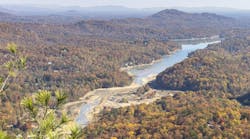
Although the problem is somewhat outside the stormwater arena, it first came to one researcher’s attention when he was staring at something we tend to know a lot about: algae. We generally want to limit algae growth in surface waters to avoid eutrophication and hypoxia. He’s also concerned about its growth—and that of other plants—but for a completely different reason.
Twenty years ago, Irakli Loladze was studying for his PhD when he came across a biology experiment in which scientists exposed algae to more light, causing it to grow faster. In turn, they expected the zooplankton that fed on the algae to flourish proportionally. They didn’t, though; although they had plenty to eat, the zooplankton began to starve. The fast-growing algae, it turned out, had far fewer nutrients, and more sugars, than algae grown at the normal rate—call it junk-food algae.
Loladze, as documented in this article, wondered whether the same effect held true for other types of plants—and if it did, what that would mean for the animals that depend on them. Plants throughout the world, including crops for human consumption, are receiving more carbon dioxide as CO2 levels in the atmosphere increase. More CO2 means greater photosynthesis. “This makes plants grow, but it also leads them to pack in more carbohydrates like glucose at the expense of other nutrients that we depend on, like protein, iron, and zinc,” according to the article.
“Every leaf and every grass blade on earth makes more and more sugars as CO2 levels keep rising,” Loladze says in the article. “We are witnessing the greatest injection of carbohydrates into the biosphere in human history―[an] injection that dilutes other nutrients in our food supply.”
Studies have shown that over the past 30 years, levels of calcium, magnesium, potassium, zinc, and iron have decreased by about 8% in a variety of plants, and the ratio of carbohydrates to minerals has increased. Concentrations of vitamins and protein are also dropping. There could be other causes, though; for example, the crops farmers now tend to favor for their high yields and resistance to pests might simply be less nutritious.
Loladze knows that more research is needed—both to determine the reason for the changed nutritional value of the plants, and to gauge what effect that might have on ecosystems and on human populations. The article includes some interesting side discussion of the difficulty of getting funding for such research, which doesn’t neatly fall into an existing category: “Biology grant makers said his proposals were too math-heavy; math grant makers said his proposals contained too much biology.”
The question is finally getting some attention; researchers in different parts of the world are now collaborating, for example, to study the effects of CO2 levels on the nutritional value of rice. Other questions remain. Some have speculated that the decline in bee populations in recent years—and the resulting threat to the plants they pollinate—might be caused in part by the drop in protein in goldenrod pollen, which has decreased by a third since the start of the industrial revolution.
About the Author
Janice Kaspersen
Janice Kaspersen is the former editor of Erosion Control and Stormwater magazines.

